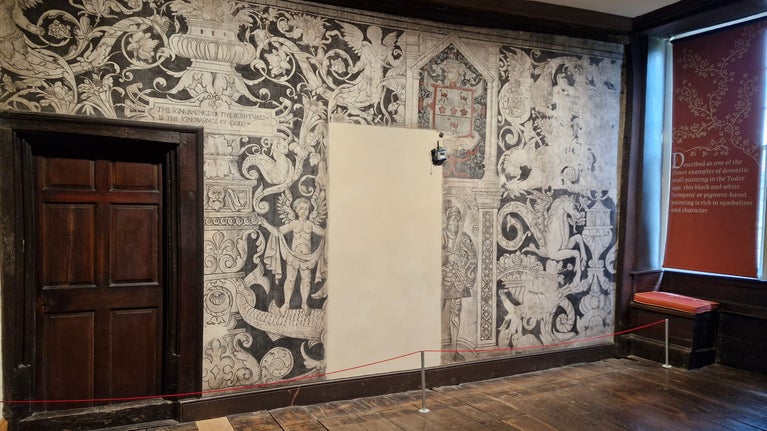Coventry’s Charterhouse gained its first royal patron after Lord Zouche died. A young King Richard II, along with his queen Anne of Bohemia, declared themselves founders and on 6 September 1385, the king came in person to lay the foundation stone of the Carthusians’ new church.
‘In the year of our Lord 1385…Richard, King of England, the principal founder of the house of St. Anne…laid the first stone in the foundation of the church with his own hands.’
– Translated from a Latin history written in the 1400s, edited by 17th century antiquarian Sir William Dugdale
Carthusian Monastery
The original monastery, the Priory of St Anne, was built of local sandstone between 1381 and 1410.
The site included a church, a chapter house, the Great Cloister surrounded by 12 individual monks’ cells, and the Prior’s Cell and refectory, now the main building known as the Prior’s House. Near the Prior’s House there was probably also a guest house, bakery, brewery, kiln house and granaries.
Each monk lived in a self-contained cell, a two-storey dwelling within a small walled garden. Remains of these cells, and of the church, have been discovered through archaeological excavation on site.
As a mostly silent order, the Carthusians embody the virtues of solitude and contemplation, and the monks would have spent the majority of their time alone in their cells without speaking. They spent their time worshiping, studying scripture and praying, attending mass at the church three times a day. The monastery was self sufficient, and the monks grew their own fruit, vegetables and herbs and fished in the river. The outer precinct walls contained not only the religious buildings and living quarters, but also an orchard, a mill, and fishponds.
Dissolution
The peaceful life of Coventry’s Carthusians came to an end in the 16th century with the dissolution of the monasteries, when Henry VIII disbanded religious communities, took over their income and seized their assets. The last prior of the Coventry Charterhouse, Prior Bochard, was forced to surrender the site to the crown on 16 January 1539.
The monks were sent away and the buildings were looted for their resources. Valuables were taken, stone and timber were immediately sold on, and 55 tons of lead was melted down and taken away. The church and many of the other buildings were demolished, but the Prior’s House and precinct walls were preserved and became a private house.
Sacred to secular
After the Dissolution, the Crown directed Henry Over, Sheriff of Coventry, to protect Charterhouse from looters. Despite this, locals helped themselves to anything they could carry.
In 1542, Henry Over bought Charterhouse for himself. The Over family transformed the Prior’s House from a religious building into a home. This work included creating a second floor by inserting a new floor into the two storey monks’ refectory. Unfortunately, this destroyed part of the medieval Crucifixtion painting that had spanned the entire refectory wall.
In the late 1560s Charterhouse was purchased from the Over family by Robert Dudley, Earl of Leicester, childhood friend, rumoured lover and long serving favourite of Elizabeth I. It is believed that the house was used to house some of the Queen’s retinue when she visited Dudley at nearby Kenilworth Castle. It is thought that Dudley is responsible for the addition of the house’s Elizabethan wall paintings, including a black and white scheme with mythical beasts and a ‘fictive’ painting which looks like a tapestry depicting foliage and fruit. It has been suggested that the central, amour clad figure depicts Dudley himself.
A house and home
By 1624, Charterhouse had come into the hands of Edward Hill, another sheriff of Coventry. The Hill family and their descendants would own the property for the next 170 years.
After Edward’s death, his daughter Ann and her husband Henry Inge took over Charterhouse, modernising the house and garden in the early 1700’s. Inside, they installed oak panelling and marble fireplaces through. Outside, they created an orangery and parkland. Their son William inherited the property after their deaths, and leased part of it to the Whittingham family.
From 1745 to 1803 John Whittingham and his son Charles ran a nursery and seed business at Charterhouse. It became one of the largest in the region, supplying trees and exotic plants to many notable place, including Warwick Castle. A diary kept by John tells us a lot about the site during this period. Around 1810, Charles Whittingham left the property and the Prior’s House became two separate dwellings. The Inge family remained the landlords until 1838.
Rediscovery
‘The property was in a very dilapidated condition; alterations and substantial repairs were at once effected, and the mansion…is now in excellent condition.’
WG Fretton, 1874
From 1848, the Wyley family owned Charterhouse. They worked as pharmacists, surgeons and entrepreneurs in Coventry. By 1853, twin brothers John and Francis Wyley were living in one side of the Prior’s House, which they extended. They let the adjoining part of the home to Sidney Henry Widdington, vicar of St. Michael’s Church, and his family.
John’s son, Colonel Sir William Wyley, also a chemist, inherited Charterhouse in 1889. He converted the Prior’s House into a fine Victorian home. During this work, he rediscovered the medieval and Elizabethan wall paintings that had been hidden behind panelling. Recognising their significance, Colonel Wyley took great care not to damage the paintings further during his renovations.
Colonel Wyley was the last private owner of Charterhouse, and died in 1940. His wife had predeceased him and their only child had been killed at the Battle of the Somme in 1916. Upon his death, Colonel Wyley bequeathed Charterhouse and much of the surrounding land to the people of Coventry. His will stated that he wished for the site to become a centre of history, culture and learning for the community to enjoy.

